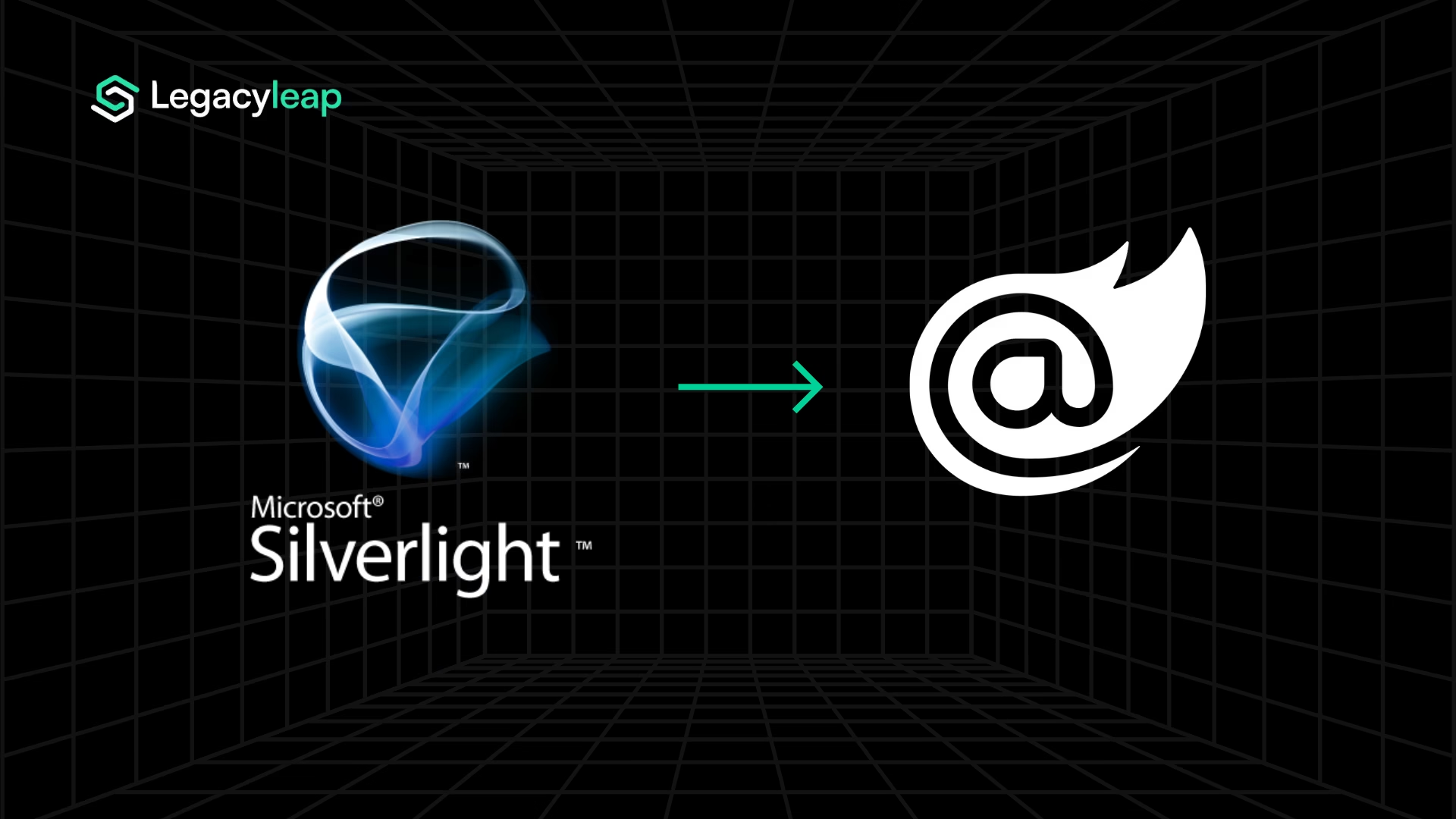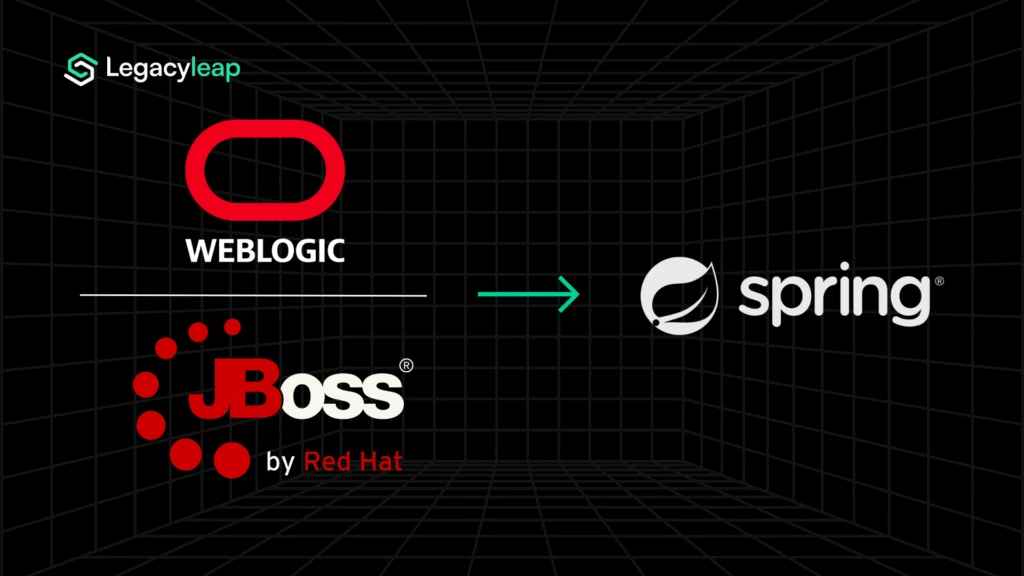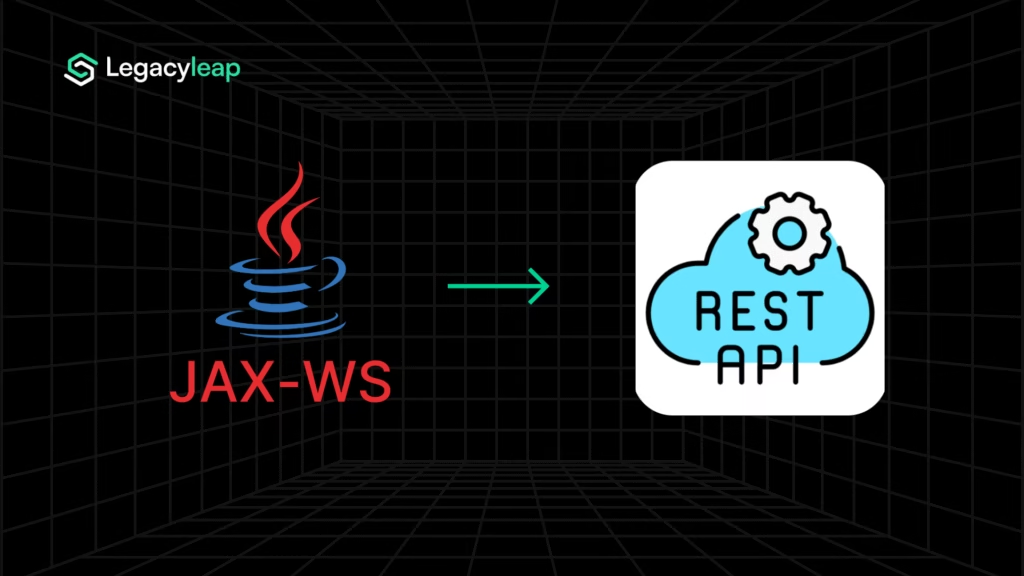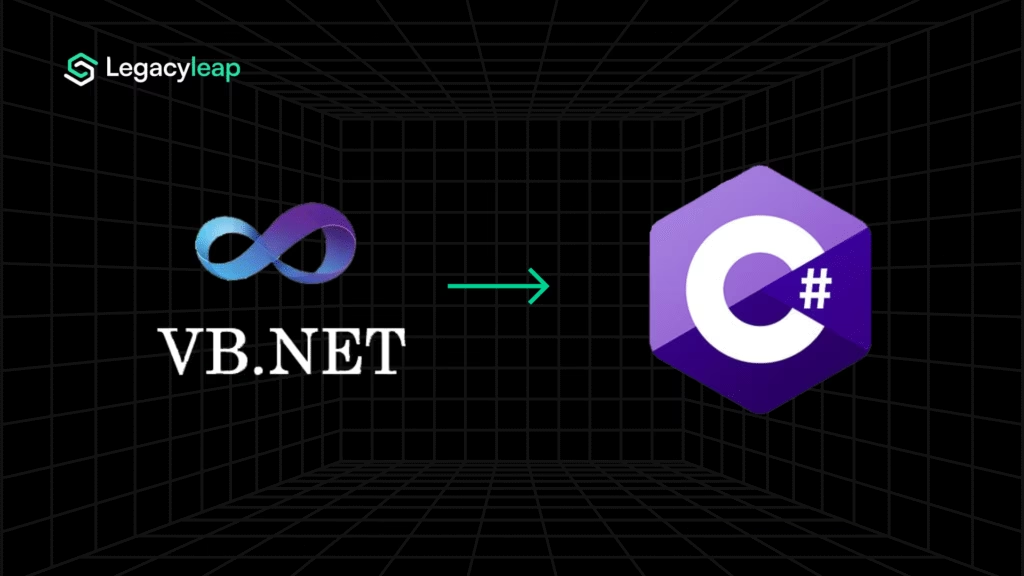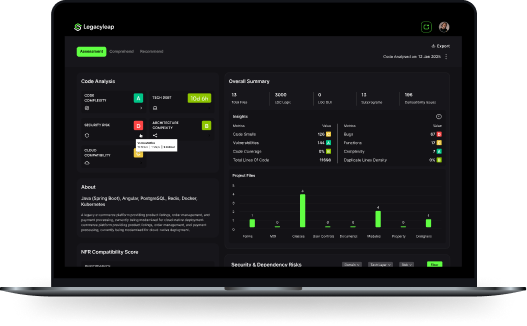Introduction: Why Silverlight Migration Can’t Wait
Silverlight has been end-of-life since October 12, 2021. It only runs in Internet Explorer 11, itself deprecated and removed from Windows 11. For enterprises, this means Silverlight applications are now stranded on an unsupported runtime with no security patches, no vendor backing, and no talent pipeline.
The risks are clear:
- Compliance exposure: Unsupported runtimes fail audit and regulatory checks.
- Operational fragility: IE11 is no longer available on modern platforms, breaking access for end users.
- Talent scarcity: Silverlight expertise has disappeared, driving up maintenance costs.
At the same time, leadership teams often ask: Is Blazor another short-lived bet like Silverlight? The answer is no.
Unlike Silverlight, Blazor is part of Microsoft’s core .NET strategy with a published LTS roadmap: .NET 8 (LTS) through 2026, .NET 9 (STS), and .NET 10 (LTS) through 2029. Blazor is not a side-technology but the forward path for enterprise .NET apps.
This blog explores why Blazor is the right destination, the pitfalls that make Silverlight migration complex, and how Gen AI with Legacyleap turns it into a safer, faster, and verifiable program.
Why Blazor Is the Right End-State for Silverlight Migration
Blazor delivers a future-proof platform that’s fully supported, rich in enterprise tooling, and flexible across modern deployment scenarios.
| Dimension | Silverlight (Legacy) | Blazor (.NET 8+) |
| Support status | End-of-life (2021) | Backed by .NET LTS roadmap |
| Runtime dependency | IE11 plugin (deprecated) | Runs in any modern browser (WebAssembly, Server, Hybrid) |
| Security | Unsupported, high compliance risk | Supported until 2026+ with ongoing patches |
| Talent availability | Scarce, legacy-only | Large, growing .NET/C# ecosystem |
| UI ecosystem | Deprecated vendor suites | Full vendor support (Telerik, Syncfusion, DevExpress) |
Key enterprise payoffs:
- Compliance confidence → align with a supported, patched platform that passes audits.
- Future-ready UI → component-based development with rich vendor support and Microsoft roadmap alignment.
- Cloud and DevOps alignment → deploy Blazor apps on containers, Kubernetes, and CI/CD pipelines.
- Unified talent pool → leverage full-stack C# developers instead of maintaining a niche skillset.
For CIOs and CTOs, Blazor is the clear successor: supported, secure, cloud-ready, and backed by a developer ecosystem large enough to sustain enterprise applications long-term.
Why Silverlight Migration Is Complex Without the Right Tools
Blazor is the Microsoft-backed successor, but the journey from Silverlight is filled with pitfalls that derail projects if handled manually:
- No direct migration path
- Silverlight UIs can’t be auto-converted. Every screen and workflow requires re-implementation.
- Enterprise risk: Long delays, high engineering cost, and loss of business logic fidelity.
- Silverlight UIs can’t be auto-converted. Every screen and workflow requires re-implementation.
- RIA Services dependency
- Many Silverlight apps depend on WCF RIA Services, which has no modern equivalent. These must be re-architected as RESTful APIs or gRPC endpoints.
- Enterprise risk: Brittle rewrites that risk data integrity and client-service communication.
- Many Silverlight apps depend on WCF RIA Services, which has no modern equivalent. These must be re-architected as RESTful APIs or gRPC endpoints.
- UI parity gaps
- Controls like DataGrid and PropertyGrid have no one-to-one Blazor equivalent. Replacement requires vendor-backed suites (Telerik, Syncfusion, DevExpress).
- Enterprise risk: Inconsistent UX, increased license cost, and extended QA cycles.
- Controls like DataGrid and PropertyGrid have no one-to-one Blazor equivalent. Replacement requires vendor-backed suites (Telerik, Syncfusion, DevExpress).
- Auth and out-of-browser features
- Silverlight’s elevated trust and OOB functionality (isolated storage, device access) don’t translate to Blazor. Teams must adopt standards (OIDC/JWT) or shift to .NET MAUI.
- Enterprise risk: Security exposure and disrupted user workflows if re-architected incorrectly.
- Silverlight’s elevated trust and OOB functionality (isolated storage, device access) don’t translate to Blazor. Teams must adopt standards (OIDC/JWT) or shift to .NET MAUI.
- Performance trade-offs
- Blazor WebAssembly vs Blazor Server vs Blazor Hybrid each carry unique trade-offs in latency, payload size, and deployment complexity.
- Enterprise risk: Poor architectural decisions leading to cost overruns or user experience degradation.
- Blazor WebAssembly vs Blazor Server vs Blazor Hybrid each carry unique trade-offs in latency, payload size, and deployment complexity.
Traditional rewrites handle these blockers manually, but they are slow, brittle, and inconsistent. Enterprises need an approach that delivers predictable outcomes with parity guarantees.
How Gen AI Makes Silverlight to Blazor Migration Safer
Enterprises exploring Silverlight migration usually find themselves with two unsatisfactory options:
- Manual rewrites: Brittle, slow, and costly. Every control, service, and business rule must be re-engineered by hand, with no guarantee of functional parity.
- Stopgaps like OpenSilver or Uno: Short-term bridges that preserve XAML but often result in dead ends, leaving organizations locked into frameworks with limited ecosystems and uncertain longevity.
Modernization needs a different playbook. This is where Gen AI with compiler-grade guardrails fundamentally changes what’s possible:
- Comprehension-first automation: Before any code is transformed, the platform ingests the Silverlight estate and auto-generates comprehensive documentation, including business logic in plain English, technical summaries, dependency graphs, and Swagger specs.
- Compiler-constrained transformation: Gen AI agents operate within Abstract Syntax Trees (ASTs) and MLIR-based intermediate representations, ensuring that generated code isn’t freeform “best guess” output, but structurally correct and production-grade.
- Functional parity validation: Automated test suites (unit, integration, and regression) are generated against the legacy Silverlight app. These become a safety net, verifying that the modernized Blazor system behaves identically before production rollout.
- Enterprise readiness by design: The platform runs securely within client environments, with options for on-prem deployment and full control over LLMs. It supports SOC 2 and HIPAA-aligned configurations, ensuring zero data leakage or vendor lock-in.
This isn’t brute-force rewriting or experimental AI code generation. It’s a purpose-built modernization engine that combines GenAI with compiler rigor, delivering automation, validation, and enterprise control at a scale that manual methods or stopgap frameworks can’t match.
Legacyleap Delivers Predictable Outcomes at Scale
What stalls most Silverlight migrations isn’t Blazor itself — it’s the complexity of undocumented XAML, RIA Services, and vendor control gaps. Legacyleap addresses these with a platformized approach that delivers predictability and parity at scale.
How the platform supports Silverlight modernization:
- Full XAML comprehension:
- Silverlight UIs are parsed into ASTs and MLIR, mapped into dependency graphs that capture controls, bindings, and event flows.
- Outcome: Leaders get a complete inventory of screens, workflows, and hidden logic before rewriting begins.
- Silverlight UIs are parsed into ASTs and MLIR, mapped into dependency graphs that capture controls, bindings, and event flows.
- RIA Services re-architecture:
- Legacy WCF RIA dependencies auto-flagged and restructured into REST or gRPC APIs, backed by EF Core for persistence.
- Outcome: Secure, scalable service layer replaces unsupported RIA Services.
- Legacy WCF RIA dependencies auto-flagged and restructured into REST or gRPC APIs, backed by EF Core for persistence.
- Vendor control mapping:
- Deprecated Silverlight controls (DataGrid, PropertyGrid, charts) mapped to modern Blazor equivalents from Telerik, Syncfusion, or DevExpress.
- Outcome: Parity in UX without months of trial-and-error control replacement.
- Deprecated Silverlight controls (DataGrid, PropertyGrid, charts) mapped to modern Blazor equivalents from Telerik, Syncfusion, or DevExpress.
- Parity-first validation:
- Golden workflows from Silverlight captured and replayed against Blazor implementations. Regression tests are auto-generated and wired into CI/CD pipelines.
- Outcome: 100% functional parity validated before cutover.
- Golden workflows from Silverlight captured and replayed against Blazor implementations. Regression tests are auto-generated and wired into CI/CD pipelines.
- Enterprise compliance and security:
- Elevated trust and OOB features refactored to modern standards (OIDC/JWT, .NET MAUI for hybrid needs). All modernization steps run fully on-prem or in client cloud environments.
- Outcome: Audit-ready migration with zero external data exposure.
- Elevated trust and OOB features refactored to modern standards (OIDC/JWT, .NET MAUI for hybrid needs). All modernization steps run fully on-prem or in client cloud environments.
- Deployment-ready outputs:
- Helm charts, Dockerfiles, and Terraform scripts generated out of the box.
- Outcome: Modernized Blazor apps roll directly into containerized or cloud-native environments.
- Helm charts, Dockerfiles, and Terraform scripts generated out of the box.
Enterprise outcomes:
- Timelines compressed from 6–12 months to 2–4 months.
- Reduced reliance on scarce Silverlight expertise.
- Predictable scope and functional assurance, backed by parity tests.
- Compliance confidence and future-ready architecture.
Plan Your Silverlight to Blazor Migration with Confidence
Silverlight is long past end-of-life. It’s unsupported, tied to a deprecated browser, and increasingly unstaffable. Every quarter spent maintaining it increases compliance risk, user disruption, and cost.
Blazor is the Microsoft-backed successor: cloud-ready, LTS-supported, with a thriving vendor and talent ecosystem. But execution is the challenge, as manual rewrites are brittle, and stopgap frameworks risk locking you into another dead end.
Legacyleap offers a different path. With compiler-grade comprehension, RIA-to-REST mapping, vendor control alignment, and CI/CD parity validation, Silverlight migration becomes a structured, verifiable modernization program that’s faster, safer, and enterprise-ready.
Start with a $0 Silverlight migration assessment. In just days, you’ll receive:
- A Silverlight dependency map
- RIA/COM risk scan
- Modernization feasibility report
- Functional documentation
A no-cost, low-risk entry point that gives leadership clarity on scope, risk, and modernization strategy.
FAQs
Delaying Silverlight migration compounds technical debt. Since Silverlight is unsupported and IE11 is deprecated, continued reliance increases security vulnerabilities, compliance risk, and the cost of future recovery.
Yes. Legacyleap separates business logic from presentation code and maps reusable components to Blazor, preserving functional integrity and reducing rework during migration.
Blazor is designed for modern enterprise needs with support for component-based UI, WebAssembly and Server hosting, and .NET LTS alignment. It scales well for complex applications when implemented with the right architecture and tooling.
Blazor runs on ASP.NET Core, inheriting its modern authentication, role-based access, and secure deployment practices. Migrating removes unsupported dependencies, enabling alignment with internal compliance and external audit standards.
With Legacyleap’s Gen AI-assisted migration, timelines are typically reduced to 2–4 months for most enterprise applications (compared to 6–12 months using manual methods) while maintaining UI accuracy and backend stability.


